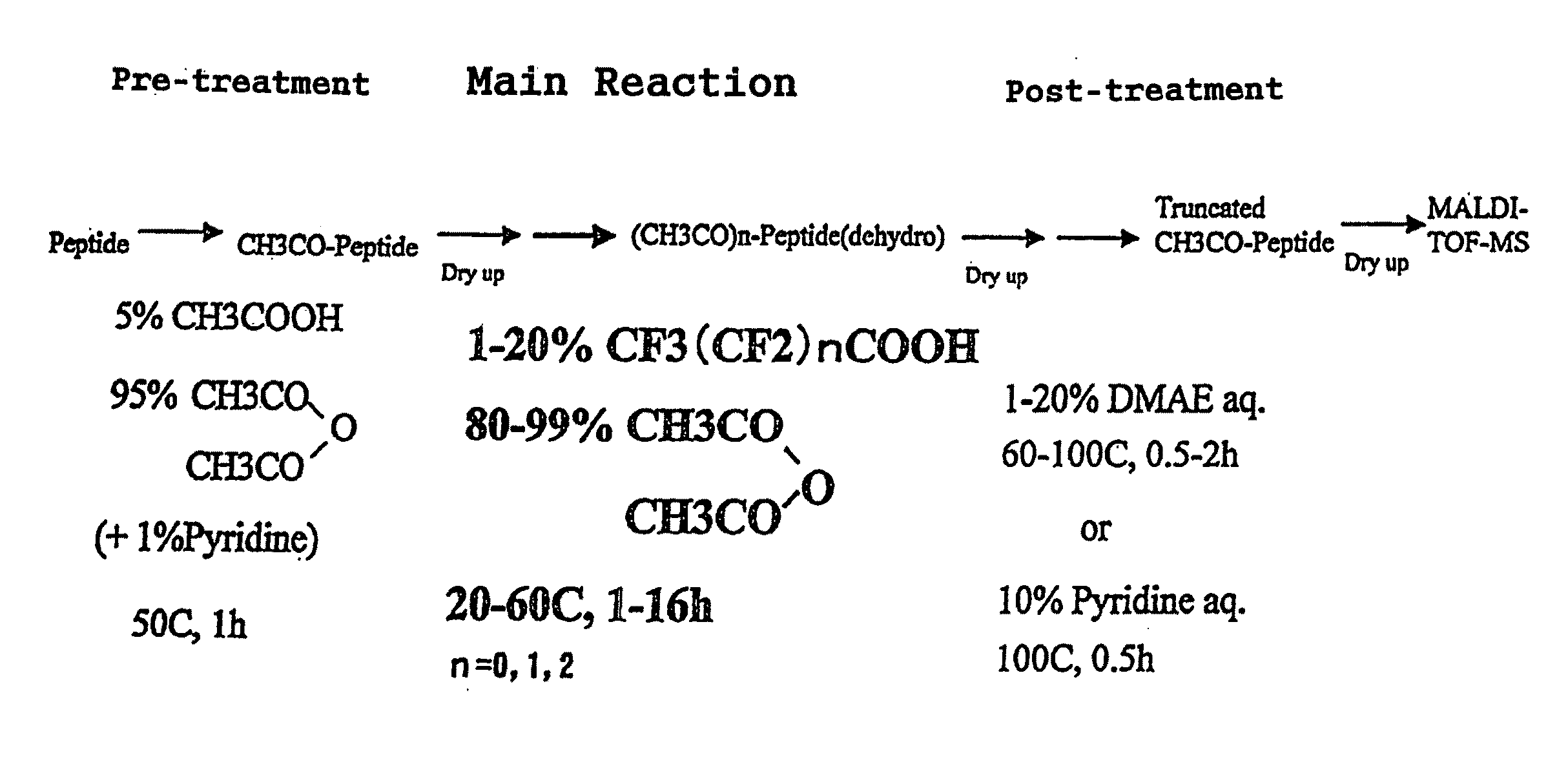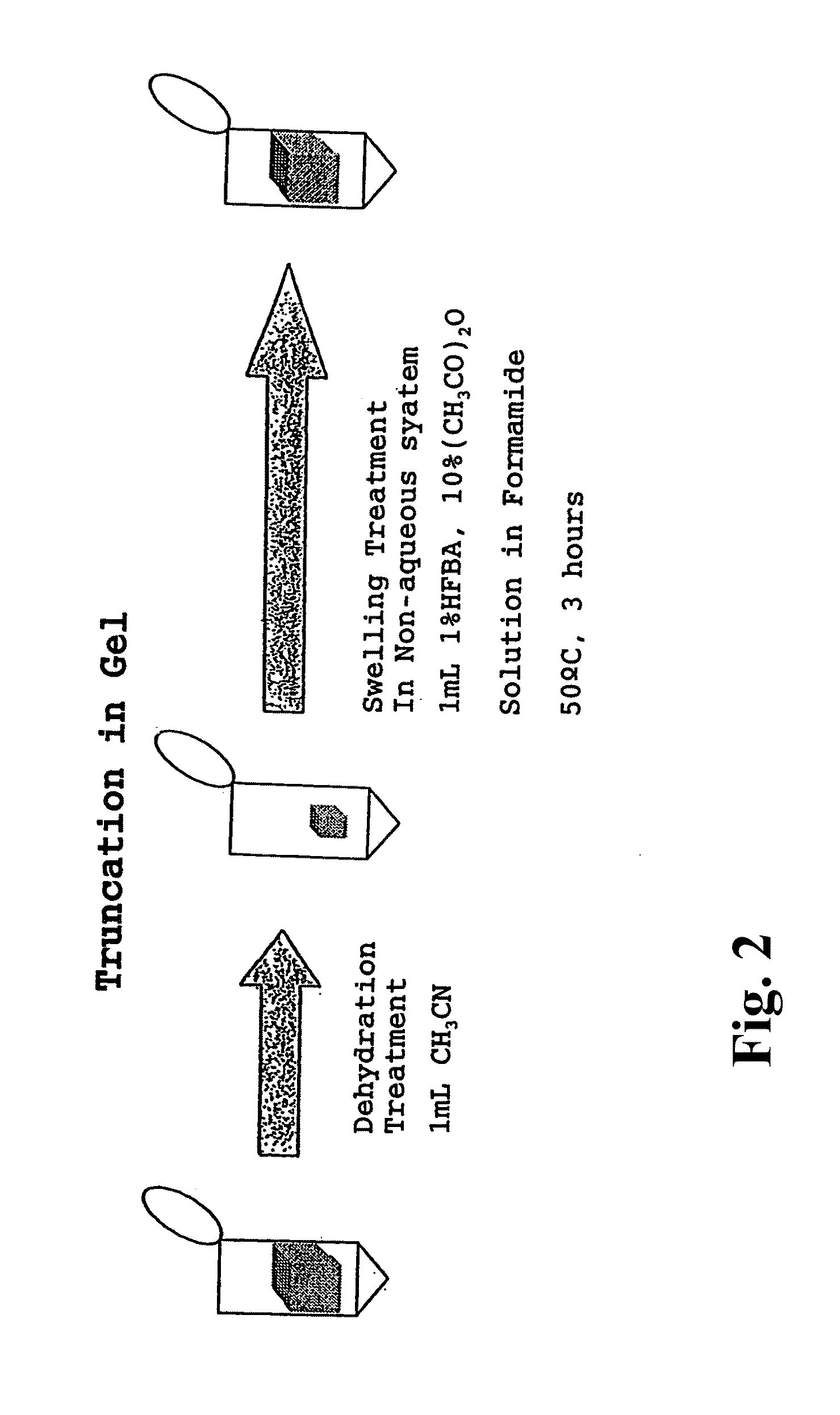Method for analyzing c-terminal amino acid sequence of peptide using mass spectrometry
a peptide and c-terminal amino acid technology, applied in the field of c-terminal amino acid sequence analysis of peptide, can solve the problems of various practical problems, and achieve the effect of high intensity and easy analysis of c-terminal amino acid sequen
- Summary
- Abstract
- Description
- Claims
- Application Information
AI Technical Summary
Benefits of technology
Problems solved by technology
Method used
Image
Examples
example 1
[0977]In order to verify the usefulness of the method for analysis of the C-terminal amino acid sequence of peptide according to the first aspect of the present invention, analysis of C-terminal amino acid sequence was conducted for globin peptide chain, a protein portion of the horse myoglobin which is a heme protein comprising 153 amino acids.
[0978]The amino acid sequence possessed by the globin peptide chain of the horse myoglobin, which is a sample to be analyzed in this Example, is already known. Using this sample, the accuracy of the identification for analysis of C-terminal amino acid sequence identified by the analysis method according to the present invention was verified. In FIG. 1 is shown a flow of the process for successive release of C-terminal amino acids, employed in Example 1.
[0979](Preparation of Isolated and Dried Peptide Powder Sample)
[0980]First, there is prepared, using a commercially available horse myoglobin standard sample, a peptide solution containing only...
example 2
[1008]In order to verify the usefulness of the method for analysis of the C-terminal amino acid sequence of peptide according to the second aspect of the present invention, analysis of C-terminal amino acid sequence of was conducted for globin peptide chain bound on the gel carrier, which is a protein component of horse myoglobin that is a heme protein comprising 153 amino acids.
[1009]In this Example, horse myoglobin, which is used as a sample to be analyzed, was subjected to gel electrophoresis by SDS-PAGE method, using a polyacrylamide gel, to separate the globin peptide chain thereof as a single spot. Then, the accuracy of the identification was verified for its C-terminal amino acid sequence determined by the method of analysis according the present invention.
[1010](Isolation by Gel Electrophoresis)
[1011]First, as for a commercially available horse myoglobin standard product, a peptide solution is prepared which contains only the globin peptide chain portion thereof at a concent...
reference example 1
[1040]In the method for analysis of the C-terminal amino acid sequence of peptide according to the present invention, a peptide chain is subjected to digestion by trypsin in a state that the side chain of lysine residue has been protected by N-acylation and, as a result, whereby the obtained common peptide fragments of N-terminal side amino acid sequence are all the peptide fragments having an arginine residue at the C-terminus; this phenomenon is utilized for distinguishment of them from the C-terminal side peptide fragments. It was verified that even if a peptide chain to be analyzed has arginine at the C-terminus, C-terminal side peptide fragments derived from a series of reaction products can be identified by obtaining, as the spectra of the main ion species reflecting the molecular weights of individual peptide fragments in measurement by means of MALDI-TOF-MS apparatus, spectra of proton (H+)-added cationic species in the positive mode detection and spectra of proton (H+)-elim...
PUM
 Login to View More
Login to View More Abstract
Description
Claims
Application Information
 Login to View More
Login to View More - R&D
- Intellectual Property
- Life Sciences
- Materials
- Tech Scout
- Unparalleled Data Quality
- Higher Quality Content
- 60% Fewer Hallucinations
Browse by: Latest US Patents, China's latest patents, Technical Efficacy Thesaurus, Application Domain, Technology Topic, Popular Technical Reports.
© 2025 PatSnap. All rights reserved.Legal|Privacy policy|Modern Slavery Act Transparency Statement|Sitemap|About US| Contact US: help@patsnap.com



